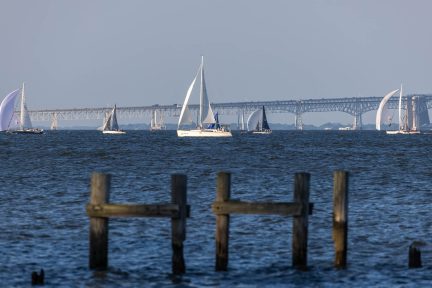Shad Abundance Surpasses Restoration Goals in Potomac, Rappahannock Rivers
Shad Abundance Surpasses Restoration Goals in Potomac, Rappahannock Rivers
Shad abundance has surged in four Chesapeake Bay rivers, surpassing the restoration goals set by the Chesapeake Bay Program in the Potomac and Rappahannock. While shad populations are at critically low levels along the Atlantic coast, scientists hope to see rising trends continue in these two rivers. Shad must have access to freshwater streams in order to reproduce, and their return to these waterways brings an important food source to the Bay in the form of protein-rich eggs, adult shad that can be captured during the spawn and a new generation of shad that can offer forage to striped bass, bluefish and other species as they return to the sea.
The Bay Program tracks the abundance of American shad in the James, Potomac, Rappahannock, Susquehanna and York rivers as an indicator of watershed health. Collectively, these five waterways account for about 90 percent of the Bay’s shad population, and each has its own population target.
Between 2000 and 2014, shad abundance in the Bay increased from 11 percent to 44 percent of the goal. The Potomac River has seen the most consistent rise in returning shad, but the Rappahannock has also seen notable highs. In 2014, abundance in the Potomac and Rappahannock reached 130 and 110 percent of the rivers’ respective targets.
Scientists attribute these increases to a series of factors, including improvements in water quality; a resurgence in underwater grass beds; moratoriums on shad harvest; an increase in habitat available to migratory fish, thanks to the installation of a fish passageway in the Potomac and the removal of the Embry Dam on the Rappahannock; stocking efforts that reprint fish to rivers and kick-start local populations; and the overall suitability of the Potomac, in particular, as shad habitat. Historic records document a remarkably productive shad fishery in the Potomac, which indicates the river’s potential for producing shad is extremely high.
Shad abundance remains negligible in the upper James and Susquehanna and variable in the lower James and York. Some variability is natural, but the continued scarcity of shad in the upper James and Susquehanna can be attributed to large dams that block fish passage and mute some of the natural cues that send migratory fish upstream.
Through the Chesapeake Bay Watershed Agreement, the Chesapeake Bay Program has committed to opening more stream miles to migratory fish and improving our capacity to understand the role forage fish populations play in the Chesapeake Bay ecosystem.
Facts
Between 2000 and 2014, American shad abundance in the Chesapeake Bay increased from 11 percent of the goal to 44 percent of the goal. Over the long term:
- Shad abundance in the Potomac River has steadily increased, and in 2011 surpassed the target. Between 2013 and 2014, abundance in the Potomac rose from 127 to 130 percent of the target.
- Shad abundance in the Rappahannock River has varied, reaching 90 percent of the target in 2003 and 2004, falling below 30 percent of the target in 2010 and reaching 93 percent of the target in 2012. Between 2013 and 2014, abundance in the Rappahannock rose from 89 to 110 percent of the target.
- Shad abundance in the York River has varied, reaching 74 percent of the target in 2001 but remaining below 40 percent of the target between 2005 and 2013. Between 2013 and 2014, abundance in the York rose from 23 to 58 percent of the target.
- Shad abundance in the lower James River has fluctuated between 4 and 27 percent of the target. Between 2013 and 2014, abundance in the lower James rose from 13 to 21 percent of the target.
- Shad abundance in the upper James River has remained negligible. Between 2013 and 2014, abundance in the upper James remained below one percent of the target.
- Shad abundance in the Susquehanna River has remained negligible. Between 2013 and 2014, abundance in the Susquehanna remained below one percent of the target.
Issues
American shad spend most of their adult lives in the ocean, migrating into the Chesapeake Bay’s freshwater rivers and streams each spring to spawn. Once one of the most valuable fisheries in the Bay, shad populations have declined in recent decades due to pollution, historic overfishing and the construction of dams that block the fish from reaching their spawning grounds. While shad recovery is still hampered by natural predation and commercial bycatch (the unintentional harvest by commercial fishermen), commercial shad harvest is closed across most of the region, and Chesapeake Bay Program partners are working to remove dams and install passageways that allow shad to reach upstream habitats.
Bay Program partners are also working to restock waterways with hatchery-raised shad, and students in Maryland, Virginia and the District of Columbia are raising shad and releasing them into the Potomac River to bring public attention to the importance of the once-forgotten fish.
Importance
American shad form an important link in the Chesapeake Bay food web: shad feed on zooplankton, and in turn offer forage to larger fish like bluefish and striped bass. Shad are also part of the region’s history and culture, and many communities still hold spring shad festivals to celebrate the return of the fish.
Quotes
“The Potomac River shad population has surpassed its sustainability target. But we want to see recovery continue until a robust population is once again providing ecological benefits and supporting a fishery that includes some recreational harvest. Hopefully, in the not too distant future, anglers will be able to enjoy shad on the table and at the end of a line.”
--- Jim Cummins, Director of Living Resources, Interstate Commission on the Potomac River Basin and Co-Chair, Chesapeake Bay Program’s American Shad Indicator Action Team
“It’s hard not to be buoyed by increases in shad abundance. Shad recovery is an important indicator of ecosystem health: where we see rising shad numbers, we know there have been harvest restrictions and improvements in water quality and fish habitat. Where numbers are low or variable, we know restricted fish passage is often to blame. Shad survival depends on access to their historic spawning grounds in our freshwater rivers and streams, and shad recovery requires sound fisheries management, habitat management and water quality management from the mouth of the Chesapeake Bay to its headwaters. A rise in shad abundance is very heartening.”
--- Nick DiPasquale, Director, Chesapeake Bay Program



